- This topic has 11 replies, 4 voices, and was last updated 5 years ago by
 Marjon.
Marjon.
-
AuthorPosts
-
14 December 2020 at 3:20 pm #574834
 Tracey SnelusParticipant
Tracey SnelusParticipantGood Afternoon
I just wanted to share with you the results that I had over the the days leading up to and into the Geminid meteor shower. On the nights of the 12th and the 13th peak levels were obtained around 22:00hrs. Yesterday (13th Dec 2020) there were 115 meteor detections between 21:00 and 22:00 which then dropped off to rates of around 50/hr.
Whilst I have had my detector set up for sometime now, it is only recently that I have started to share the information. I also share this data to the RMOB. I am happy to share the data and or learn new methods or ways to refine the set up that I have.
Thank you
Tracey
Attachments:
14 December 2020 at 11:46 pm #583568 Bill WardParticipant
Bill WardParticipantHi,
Looks good! I also noticed the enhanced activity around 22-23hr. The traditional peak seems to have been down a bit compared to that hour. ~200+/hour compared to ~160/hour in the morning hours.
I set up the screen capture in SPECTRAN to see how the activity would develop.
Here’s a radio “movie” of six hours worth of activity from this morning. https://youtu.be/9xQ_CvAXWGA
Cheers,
Bill.
15 December 2020 at 12:57 am #583569 Bill WardParticipant
Bill WardParticipantHi,
Had a quick look at my HROfft images and 2320 seems to have been the 10 min interval with the highest activity!
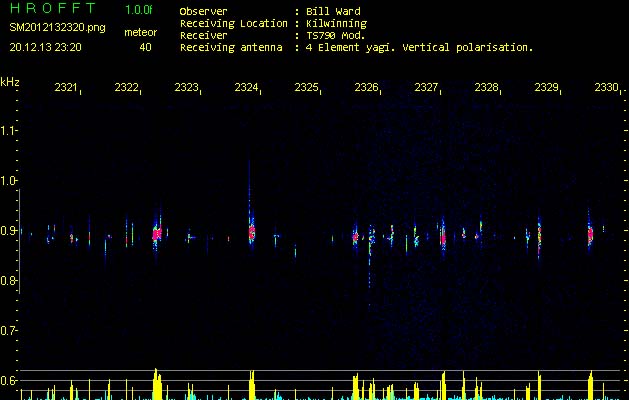
Lots of meteors! : – 0
I did have one frame with 46 meteors but it also had some interference that might have bumped to count up a little.
Here’s a higher temporal version with the big ping just after 2322…
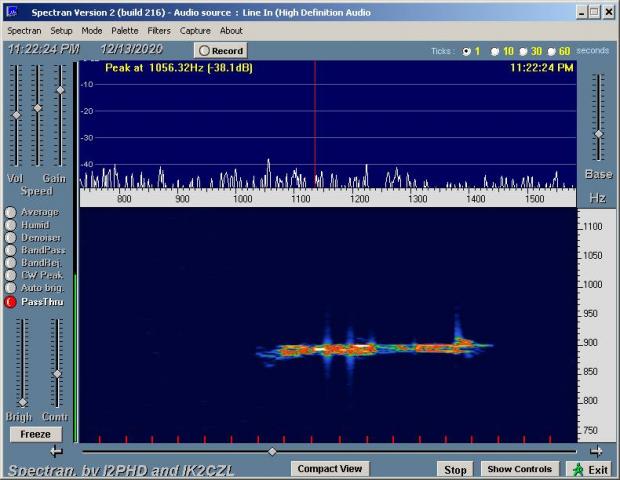
The red tick marks at the bottom are at 1 second intervals.
It’s all good fun.
Cheers,
Bill.
15 December 2020 at 7:15 pm #583573 Tracey SnelusParticipant
Tracey SnelusParticipantThank you for sharing the above information. I was expecting for the rates to keep on escalating up especially with the peak expected at earlier hours in the morning. However I have soon learnt that the predictions do not always tie up to what I observe. I hate to admit it but I did take great pleasure in listening to the pings especially when they kept on coming through. As you also noted there were some really nice long traces coming through. The rates have dropped pretty significantly now my peak since midnight has been 16 hits.
Thanks again
Tracey
16 December 2020 at 3:50 pm #583575 Mike GermanParticipant
Mike GermanParticipantThese are all interesting measurements Tracey and Bill. Also interesting the individual approaches we take to capture and display our data.
Here are counts from my three experimental antenna systems. On the 13th the highest count is in the hour starting 21:00 UT and on the 14th the peaks are in the hour from 23:00. (NB total counts without allowance for sporadics)

I note from the BAA Handbook the predicted maximum was 13th at 20:00 which I calculate as corresponding to a solar longitude of 261.995 which compares withe IMO listing of the 14th with solar longitude 262.2. (sorry, I can’t work back to UT) At my location the maximum radiant elevation was at around 02:00 UT on both days
Mike
Hayfield, High Peak
16 December 2020 at 5:44 pm #583576 Bill WardParticipant
Bill WardParticipantHi Tracey,
I know what you mean, I’ve not had my system on for months, gave up with auto updates shutting down my machine…
It’s intriguing listening to the pings, that was the only reason I put it on! The longest ping I recorded this time was about 1 minute. I too was surprised by the fall off in activity as it does normally climb as the geometry improves in combination with the radiant rising. … but predictions are just that…
You tend to get longer echoes with higher velocity meteors (Perseids and Leonids) since they dump at lot more energy into the atmosphere per unit mass.
I don’t know if it’s still available but the IMO Radio workshop/handbook proceedings is a good review of radio observations.
The SDR dongles have certainly made the hardware less expensive. I’ve used a couple in various set ups over the past few years but my old ham radio set still seems to be the best performer!
I’ll probably shut it down after the Quadrantids…
Mike, what antennae were you experimenting with? I’ve been using a 4 element for over a decade at my current location. Longer antenna haven’t really improved the situation much (Beamwidth/gain compromises) but have toyed with the idea of constructing an old fashioned full wavelength co-linear array. I found the change from horizontal to vertical polarisation significant. Yagis may be better for comms but I think when it comes to meteor observing there are different issues…
Cheers,
Bill.
17 December 2020 at 4:23 pm #583585 Mike GermanParticipant
Mike GermanParticipantBill
I have had a PC and laptop used for RA stuff running 24/7 for 3 months or so – the secret is using something like “Stop Updates 10”; it does what it says!
With regard to the antennas, two are show in my picture, shown against a pink sunrise. They are, to give them their full title, cross polarisation 3 element LFA (Loop Fed Array) Yagis (Red and Green systems). The antennas are completely separate electrically. They point vertically and the elements point 45 degrees either side of GRAVES bearing. They are very much an experimental arrangement and the idea is that because the patterns in this orientation are ( I believe) akin to a dipole (exact modelling or measurement is a problem ) there is some direction discrimination. The other antenna is a 2 element LFA in traditional horizontal polarization configuration (Blue system). I am fairly sure GRAVES transmits vertical – certainly their recieving array are verticals so that would account for the better performance.
Mike
17 December 2020 at 8:45 pm #583588 Bill WardParticipant
Bill WardParticipantMike,
Where do I find “Stop Updates 10″….? My excursions in the various settings/options/advanced options have failed to reveal to me such a function. I can find notify and delay options, updating all sorts of functionality individually but nothing that actually stops the updates completely.
Your help would be appreciated.
Bill.
18 December 2020 at 12:29 am #583589 MarjonParticipant
MarjonParticipantHi,
It’s good to have an opportunity to compare my results with other observations and recording methods.
I began running my set up in early 2019, concentrating on the major meteor showers. However, this year I have left it running full time.For the recent Geminids I recorded just over 80 counts (raw data) for the peak on the 13th December (day#347), which I found to be at 20:00hrs. There was also some activity in the early hours of the 14th. Processing my data to reduce interference, reduced the peak count to 64. See images below.
I am recording my data using a Raspberry Pi 4B, running GQRX and python logging code, connected to a 3-element Yagi. I then process and plot the data using python on a laptop running Ubuntu Linux.
Regards,
Mark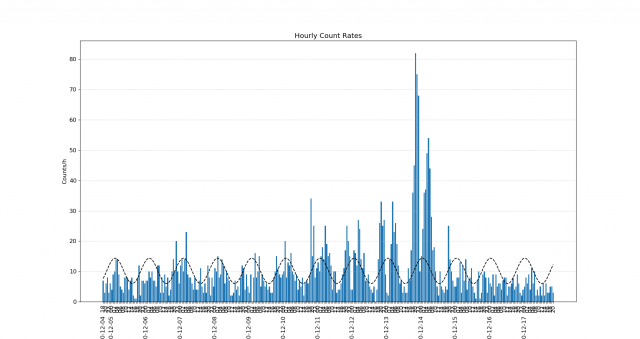
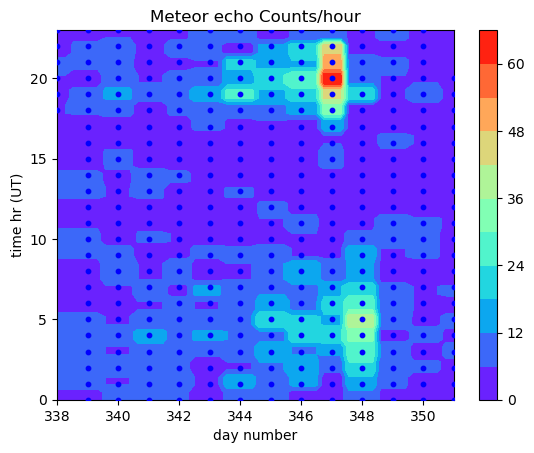 18 December 2020 at 10:05 am #583590
18 December 2020 at 10:05 am #583590 Mike GermanParticipant
Mike GermanParticipantBill,
it is not part of windows it is an app that you should be able to find with a search enigine. I have sent a BAA email with the address.
Mike
18 December 2020 at 11:54 am #583592 Mike GermanParticipant
Mike GermanParticipantMark,
I too welcome the opportunity to compare methods and results. What is your location? I am in Hayfield in the Peak District. Here is my colour chart from one of the systems.
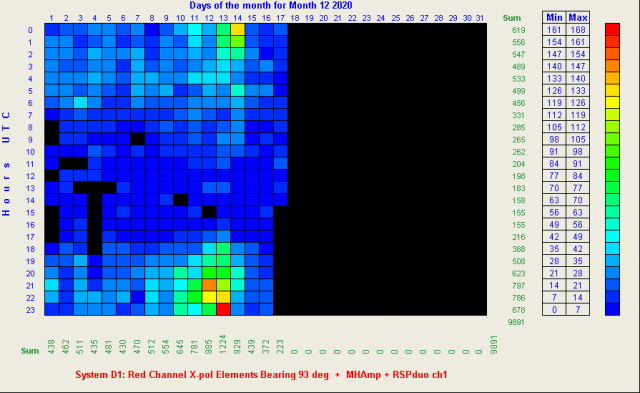
Filtering non-meteor events from the logged data is a tricky one; I select and reject using calculated characteristics of each event. For this system over 30% were rejected or which many were probably meteors.
I think one reason I may have relatively high count rates is because the FFT in the capture and logging program provides higher resolution in time (~10ms) rather than in frequency; this detects shorter duration meteors than, say, Spectrum Lab set-ups normally do.
The antennas in the vertical configuration do not utilse the maximum gain; I has mast head LNAs to provide a little boost to the signals.
Mike
18 December 2020 at 2:43 pm #583595 MarjonParticipant
MarjonParticipantMike
I am located in Westerham, Kent and have a good view of the sky from the south-east to the west.
I just use a basic antenna for this with no LNA. It is in a horizontal configuration and positioned in the loft space, which may be why I tend to get a weaker signal. I have a couple of other types of antenna, located in better positions, that I use for other radio astronomy projects. One of which uses an LNA module for hydrogen line applications.
As far as non-meteor events are concerned, the software removes signals that don’t contain at least one frequency near an estimated reference-frequency, hopefully keeping the meteor echoes. Its, not perfect though. I will have to try any determine what percentage of signal are actually removed.
Mark
-
AuthorPosts
- You must be logged in to reply to this topic.
